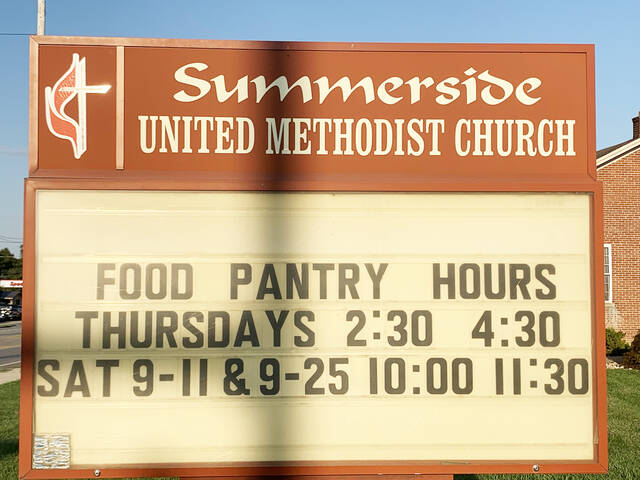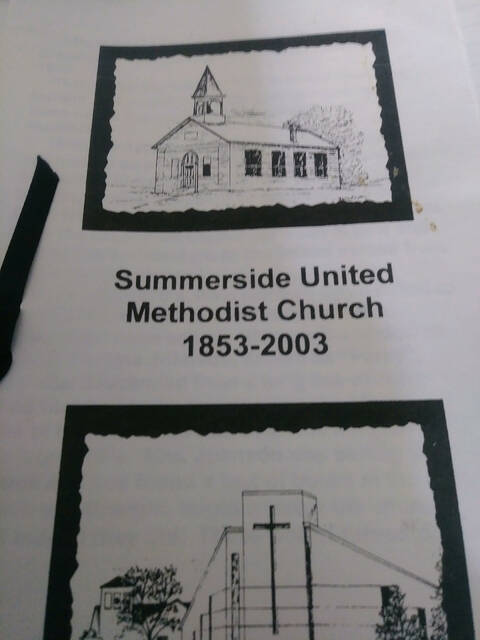
Pictured is Summerside United Methodist Church, which is expected to close as soon as this month due to financial insolvency. Members of the congregation are attempting to save the church.
Summerside congregation: ‘This is our church’
Summerside United Methodist Church is expected to close its doors by the end of the month due to debts and lack of incoming donations, according to the West Ohio Conference of the United Methodist Church.
In April, the congregation was told that Summerside was approaching financial insolvency due to operational costs combined with dwindling members and donations.
The congregation holds the building in trust.
Some of that can be put at the doorstep of COVID-19, which caused the church to be closed for the better part of a year. With in-person worship not occurring, people were less likely to donate.
The congregation voted down a resolution to close the church, with a plan to “rebirth” the church, which includes replacing its pastor, Rev. Nicole Henderson-Johns. There’s no personal animus against Henderson-Johns, but rather a financial question of continuing to pay her salary and benefits, as required by being part of the United Methodist Church.
The church, located at 638 Old State Route 74, has been around for nearly 170 years.
Some residents in the county have been attending Summerside for decades. For example, Betty Snider, who The Sun profiled on occasion of her 90th birthday in 2019, has been going to the church since she was a child.
Members of the church have likened the situation at Summerside to the Biblical David vs. Goliath story, where David represents the small congregation and Goliath represents the United Methodist Church.
The West Ohio Conference has eight districts overseeing its local churches, with Summerside being in the Ohio River Valley district.
Each District is led by a District Superintendent, tasked with overseeing the ministry of the district’s clergy and churches, providing spiritual and pastoral leadership and oversees programs within the District.
Rev. Todd Anderson oversees the Ohio Valley District.
The Sun was unable to reach Kay Panovec, the communications director for the Ohio Valley District ahead of print time.
At Summerside, Henderson-Johns presides; she is also the pastor at Batavia United Methodist Church.
Henderson-Johns said unfortunately, they can’t run an organization on less than $100 coming in every week on an offering plate.
There’s a life cycle of any church, she said. Churches rely on those donations and gifts. Add in membership numbers dropping and new members not coming in and that’s where the problems exist. But it could be turned around, if new things were tried and accepted.
When a church comes to a point of no longer being a viable church, there’s a lot of difficult decisions to be made and the Conference is walking them through that process, she said.
Throughout the pandemic, Henderson-Johns said they maintained a cautious approach to opening the doors to protect its members, particularly vulnerable adults. However, that meant people who wanted in-person worship elected to go elsewhere.
Pre-pandemic, the congregation numbered 110 per week. Nowadays, that number is at 30, although the latter number doesn’t take into account those who may still be watching the service online still to the pandemic.
“I am following my call to ministry, which is to lead the church in terms of the organization in order of the church and administration of the church. And part of that is to do some things that people don’t like and part of that is to do things that are on behalf of the bigger church. And it’s hard. It’s a hard thing to do in good times and in bad, but especially in bad when everybody is struggling and grieving,” Henderson-Johns said.
That call includes the four tenants of the United Methodist Church: Order, service, sacrament and the Word.
Henderson-Johns said Summerside continues to offer its food pantry services on Thursdays from 2:30 p.m. to 4:30 p.m. and the second and fourth Saturday each month from 10:00 a.m. to 11:30 a.m.
“We’re still serving those clients and ensuring that food gets into the hands of people that need it. And we’re looking at ways of continuing that ministry post-closure of the church, so that there’s some other churches that will be stepping in to help and making sure that that happens,” she said.
On the question of her salary, Henderson-Johns said she is paid according to the paying structure of the United Methodist Church for a full-time Elder in good standing.
She said she’s actually paid less than the majority of the Elders with similar education level and experience in the area and throughout the Conference.
Henderson-Johns said the community she serves is very “near and dear” to her and that’s why she continues serving.
The members have signed a petition to keep the church open and have a plan in place.
Marsha Lohbeck, one of the congregation members, told The Sun the rebirth plan they’ve proposed would be, “The Nehemiah Initiative.”
“The Nehemiah Initiative proposes to keep expenses low with volunteer staff, sale of the church parsonage to pay off church debt, and possibly allowing other suitable organizations to use parts of the building for donations to help with expenses,” she said. “With less debt, the church would be in a better position to stay open and provide more outreach and mission work to our community.”
Lohbeck said that plan is “constrained by the debts associated with being part of the United Methodist conglomerate,” which she said includes pastor salary and expenses, family benefits and apportionments.
On Aug. 22, Anderson presided over the vote on a closing date of late September, with the resolution failing. But a member resolution to sell the parsonage, which houses the pastor, passed unanimously, Lohbeck said.
According to the county auditor’s site, the appraised value of the Summerside building is $1.2 million, with the land valued at $581,600, bringing the total value to nearly $1.8 million, as of 2020.
Jack Gray, a congregation member for more than 40 years, said none of this is really about the money or any personal issues with the pastor; rather, it’s about maintaining that building and that space as a place of worship.
Gray explained the Nehemiah plan being so named after Nehemiah in the Book of Nehemiah, who rebuilt the wall around Jerusalem to protect the city because that’s what the congregation views itself as doing: coming together to rebuild the church.
Financially, the local congregation just can’t afford to maintain a relationship with the United Methodist Church, if they continue to want Summerside to have a full-time, or even part-time, pastor, Gray said.
The nitty-gritty of the Nehemiah plan is that by only having a volunteer staff and not paying a pastor salary, the congregation could put that money toward the annual mortgage payment of $40,000 to $50,000.
The overall mortgage is between $230,000 to $240,000.
In addition, the congregation owns that parsonage and if they didn’t have a pastor, they could sell the parsonage, which is valued at somewhere between $250,000 to $300,000.
Upkeep on the building is an additional cost of $50,000 annually.
All of that would help go toward paying off the debt of the church.
“So, you could take the existing congregation and the people that are supportive of continuing as a congregation and well afford to pay the bills on the building,” Gray said.
In addition, the plan would reconstitute a board and organizational structure that would not be affiliated with the United Methodist Church, but would maintain the same location and congregation to “glorify God.”
There’s a feeling among the local members of the church — who have paid all the bills, financed and paid the mortgages, and built the buildings — that this is “our church.”
“And yet, the very membership as part of the United Methodist Church speaks differently to that,” he said.
Gray said the congregation is just trying to look for a path forward.
“This is going to come to a decision pretty quickly and I don’t think I can do it, I don’t think the congregation can do it by themselves, but with God, we can do anything,” he said. “This is not unlike David and Goliath. We have the huge and powerful United Methodist Church organization and we have this small, dwindling congregation in Summerside that are trying to hang on to what we believe God put in our charge to be stewards of and use it best to glorify Him.”



